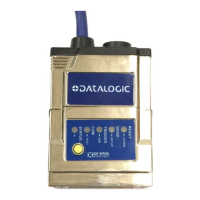MATRIX 210N™ REFERENCE MANUAL
10 TECHNICAL FEATURES
0.35 to 0.13 A,
3.9 W max.;
0.4 to 0.15 A,
4.5 W max.;
Main
- RS232
- RS422 full-duplex
2400 to 115200 bit/s
2400 to 115200 bit/s
2400 to 115200 bit/s
2400 to 115200 bit/s
USB 2.0 up to
921600 bit/s
Inputs: Input 1 (External Trigger) and Input 2
Opto-coupled and
polarity insensitive
Opto-coupled and
polarity insensitive
Outputs
7
Output 1 and Output 2
V
OUT
(I
LOAD
= 10 mA) Max.
CMOS sensor with Global Shutter
up to 60 frames/sec. @ full window size
Internal LED Illuminator to EN 62471
Blue Ring;
for liquid lens models only:Laser Pointers IEC 60825-1 2007
See chapter 6 for other optical features
0 to 50 C (32 to 122 °F)
for liquid lens models only: 0 to 45 C (32 to 113 °F)
-20 to 70 C (-4 to 158 °F)
Vibration Resistance
EN 60068-2-6
14 mm @ 2 to 10 Hz; 1.5 mm @ 13 to 55 Hz;
2 g @ 70 to 500 Hz; 2 hours on each axis
Bump Resistance
EN 60068-2-29
30g; 6 ms;
5000 shocks on each axis
Shock Resistance
EN 60068-2-27
30g; 11 ms;
3 shocks on each axis
Protection Class
9
EN 60529
for Ethernet models only; supports application protocols: TCP/IP, EtherNet/IP, PROFINET-IO, Modbus TCP
when connected to the CBX connection boxes the electrical features for Output 1 and 2 become the following:
Opto-isolated; VCE = 30 Vdc max.; ICE = 40 mA continuous max.; 130 mA pulsed max.;
VCE saturation = 1 Vdc max. @ 10 mA; PD = 90 mW Max. @ 50 °C ambient temp.
high ambient temperature applications should use metal mounting bracket for heat dissipation.
IP64 for ESD models

